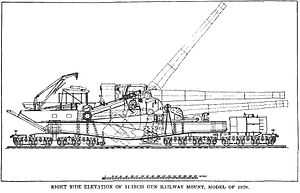14-inch M1920 railway gun
| 14-inch M1920 railway gun | |
|---|---|
|
Diagram showing gun barrel in elevated, normal and traveling positions | |
| Type | Railway gun |
| Place of origin | United States |
| Service history | |
| In service | 1925 to 1946 |
| Used by |
|
| Wars | World War II |
| Production history | |
| Designed | 1920 |
| Manufacturer | Watervliet Arsenal |
| Produced | 1925 |
| Number built | 4 |
| Specifications | |
| Weight | Tube and recoil band- 230,000 Lbs |
| Length | (18.1 m) 59 feet 6 inches |
|
| |
| Shell | separate loading, HE, and AP |
| Caliber | 14-inch (355.6 mm) |
| Breech | Interrupted thread, (step-cut) |
| Recoil | hydropneumatic |
| Carriage | railway truck, 14 axles |
| Elevation | 50° fixed, 19° on track |
| Traverse | 7° on track, 360° fixed |
| Rate of fire | 1 rpm |
| Muzzle velocity | 2,650 feet per second (808 m/s) |
| Effective firing range | 22,092 m (48,220 yd) |
| Feed system | hand |
The 14-inch M1920 railway gun was the last large caliber railway gun to be deployed by the U.S. Army. It was an upgrade of the Navy 14"/50 caliber railway gun. This was meant to build a better railway gun, from past mistakes.
History
After the close of World War I, the US Army wanted to incorporate the lessons learned from other railway gun mounts and fulfill coastal artillery requirements for hitting a moving target. An effort to design a more universal mount for the Navy's Mk. IV 14"/50 caliber gun was undertaken.
The primary difference from the earlier Navy versions lies in the M1920 carriage, which could be raised and lowered. Prepositioned fixed mounts were installed at the forts, and the gun's rail trucks could be taken out from under the frame. After the removal of the rail trucks, the gun was lowered and bolted onto a pivot point for 360 degree movement. The M1920 carriage made the gun much more flexible. It allowed for the standard practice of using a curved piece of rail to traverse the gun, and it enabled the gun to be used in a fixed position.
Two guns were deployed to Fort MacArthur. The remaining two guns were deployed to Fort Grant and Fort Randolph in the Panama Canal Zone. The two guns deployed to the Panama Canal Zone could be moved to either coast on the Panama Canal Railway.
Models
The Mk.IV gun was manufactured in two models:
- M1920MI centerline of breechblock mechanism canted 16 degrees counterclockwise to fit recoil band
- M1920MII breech mechanism is set straight in relation to axis of tube.
Sighting and fire control equipment
The following sighting equipment was used with the gun:
- M1 fire adjustment board
- M1 plotting and relocating board
- M1A1 range correction board
- M7 spotting board
- M1912A1 clinometer
- M1A1 height finder
- M1910 azimuth instrument
- M8 helium filling kit
- M1 gunners quadrant
- M1918 aiming rule
- M1 prediction scale
- bore sight
- firing tables- 14-m-1, 14-e-3, 14-g-2.
- M1917MI panoramic telescope
- M1922 panoramic telescope
- M1 generating unit (mounted on the forward railway truck)
Support cars
- M1 powder car
- M1 projectile car
- M2 fire control car
- M1918 repair car
Surviving artifacts
All four guns were cut up for scrap in 1946.
See also
- 14"/50 caliber railway gun US World War I predecessor
- List of U.S. Army weapons by supply catalog designation
- Railway gun
- Indirect fire
- Gun laying
- Coincidence rangefinder
- Sound ranging
- Coast Artillery fire control system
- Angular mil
References
- Military Railroads on the Panama Canal Zone by Charles S. Small, Railroad monographs 1982
- Railway Artillery: A Report on the Characteristics, Scope of Utility, Etc., of Railway Artillery, Volume II. Department of the Army, Ordnance Department. Washington, D.C.: Government Printing Office.
- TM 9-2300 Standard Artillery and Fire Control Material. dated 1944
- FM 4-35 Service of the Piece; 14-inch Gun, M1920MII on Railway Mount, M1920 (1940)
- SNL E-9
- SNL E-33
- Coast Artillery Journal December 1929
- American Coast Artillery Materiel 1922 (extensive manufacturing information)
- Coast Artillery Journal March April 1934
External links
- "Gun Train Guards Ends of Panama Canal -- Rolling Fort Crosses Isthmus in Two Hours" Popular Mechanics, December 1934 pp.844-845 excellent drawings in article
| ||||||||||||||||||||||||||||||||||
